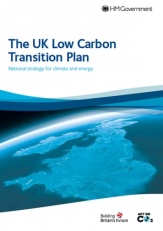Low Carbon Transition Plan
UK emissions of the basket of six greenhouse gases covered by the Kyoto Protocol were 22.0 per cent lower in 2008 than they had been in 1990, down from 779.9 to 608.4 million tonnes carbon dioxide equivalent. The Climate Change Act 2008 established a legally binding target to reduce the UK’s greenhouse gas emissions by at least 80% below 1990 levels by 2050.
To drive progress and set the UK on a pathway towards this target, the Act introduced a system of carbon budgets which provide legally binding limits on the emissions that can be produced in successive five-year periods, beginning in 2008. The first three carbon budgets were set in law in May 2009.
- 2008-2012, 23% reduction below 1990 levels.
- 2013-2017, 29% reduction below 1990 levels.
- 2018-2022, 35% reduction below 1990 levels.
The Low Carbon Transition Plan: National strategy for climate and energy, was published by the government in July 2009. It set out the strategy for meeting these three carbon budgets. It showed how reductions in the power sector and heavy industry; transport; homes and communities; workplaces and jobs; and farming, land and waste sectors could enable carbon budgets to 2022 to be met.
The Low Carbon Transition Plan was an overarching document and a number of more detailed documents were published alongside it:
- Low Carbon Transport – a Greener Future (DfT), setting out how to reduce carbon emissions from domestic transport over the next decade.
- UK Low Carbon Industrial Strategy (BIS and DECC), presenting a series of active interventions to support industries critical to tackling climate change.
- UK Renewable Energy Strategy (DECC), setting out the role individuals, communities and businesses can play in promoting renewable energy.
A fourth carbon budget, covering the period 2023–27, was set in law on 30 June 2011.
- 2023-2027, 50% reduction below 1990 levels.
The Carbon Plan: Delivering our low carbon future, published in December 2011, updated and superseded the Low Carbon Transition Plan and presented the Government’s strategy for meeting all four carbon budgets, with a particular focus on the fourth carbon budget.
On 15 December 2015, the Green Construction Board published, Low Carbon Routemap for the Built Environment, 2015 Routemap Progress | Technical Report. This updated the Low Carbon Routemap for the Built Environment prepared in 2013 aimed at delivering an 80% cut in UK built environment carbon emissions by 2050 compared to 1990 levels.
It found that annual emissions in the UK had actually increased since 2009, primarily due to an increase in gas consumption from heating. The report states “There has been a growing divergence occurring over just a few years (2009 through 2013). Given the steepness of the trajectory required to meet the ambition for built environment carbon reductions (and statutory targets for the UK as a whole), a significant transformation from the ongoing ‘status quo’ trajectory is needed.”
It also found a slight increase in ‘capital carbon’, suggesting “The data provides no evidence of a trend driven by efficiencies or process improvements in design, manufacturing or the supply chain."
[edit] Related articles on Designing Buildings Wiki
- CRC Energy Efficiency Scheme.
- Climate Change Act
- Climate Change Levy.
- Energy Act.
- Energy related products regulations.
- Green deal.
- Greenhouse gases.
- Kyoto Protocol.
- National Adaptation Programme.
- Routes to low carbon energy.
- Subsidy-free low carbon electricity.
- Sustainability.
- The Carbon Plan: Delivering our low carbon future.
- Zero carbon homes.
- Zero carbon non-domestic buildings.
Featured articles and news
RTPI leader to become new CIOB Chief Executive Officer
Dr Victoria Hills MRTPI, FICE to take over after Caroline Gumble’s departure.
Social and affordable housing, a long term plan for delivery
The “Delivering a Decade of Renewal for Social and Affordable Housing” strategy sets out future path.
A change to adoptive architecture
Effects of global weather warming on architectural detailing, material choice and human interaction.
The proposed publicly owned and backed subsidiary of Homes England, to facilitate new homes.
How big is the problem and what can we do to mitigate the effects?
Overheating guidance and tools for building designers
A number of cool guides to help with the heat.
The UK's Modern Industrial Strategy: A 10 year plan
Previous consultation criticism, current key elements and general support with some persisting reservations.
Building Safety Regulator reforms
New roles, new staff and a new fast track service pave the way for a single construction regulator.
Architectural Technologist CPDs and Communications
CIAT CPD… and how you can do it!
Cooling centres and cool spaces
Managing extreme heat in cities by directing the public to places for heat stress relief and water sources.
Winter gardens: A brief history and warm variations
Extending the season with glass in different forms and terms.
Restoring Great Yarmouth's Winter Gardens
Transforming one of the least sustainable constructions imaginable.
Construction Skills Mission Board launch sector drive
Newly formed government and industry collaboration set strategy for recruiting an additional 100,000 construction workers a year.
New Architects Code comes into effect in September 2025
ARB Architects Code of Conduct and Practice available with ongoing consultation regarding guidance.
Welsh Skills Body (Medr) launches ambitious plan
The new skills body brings together funding and regulation of tertiary education and research for the devolved nation.
Paul Gandy FCIOB announced as next CIOB President
Former Tilbury Douglas CEO takes helm.
UK Infrastructure: A 10 Year Strategy. In brief with reactions
With the National Infrastructure and Service Transformation Authority (NISTA).























